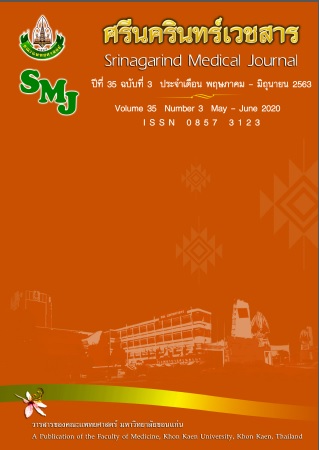ผลของสารสกัดเกสรบัวหลวงต่อความจำบกพร่องในหนูแรทที่ถูกเหนี่ยวนำด้วยแอมีลอยด์บีต้า
คำสำคัญ:
แอมีลอยด์บีต้า; เกสรบัวหลวง; การเรียนรู้และความจำ; ภาวะเครียดออกซิเดชันบทคัดย่อ
หลักการและวัตถุประสงค์: เกสรบัวหลวงเป็นพืชสำคัญทางการแพทย์แผนไทย มีฤทธิ์ต้านเบาหวาน ต้านอนุมูลอิสระ และยับยั้งเอนไซม์อะซิทิลโคลินเอสเทอเรส นิยมบริโภคเป็นอาหารสุขภาพ การศึกษานี้เป็นการประเมินผลของสารสกัดเกสรบัวหลวงต่อภาวะความจำบกพกพร่องในหนูแรทที่ถูกเหนี่ยวนำด้วยแอมีลอยด์บีต้า
วิธีการศึกษา: หนูแรท เพศผู้ พันธุ์ Sprague Dawley จำนวน 40 ตัว แบ่งเป็น 5 กลุ่ม กลุ่มละ 8 ตัว ดังนี้ กลุ่มที่ 1 กลุ่มควบคุมปกติ กลุ่มที่ 2 กลุ่ม V+Aβ ได้รับ 0.5% sodium carboxymethyl cellulose ทางปาก และถูกฉีดด้วยแอมีลอยด์บีต้าเข้า lateral ventricles กลุ่มที่ 3 กลุ่ม Vit C+Aβ ได้รับวิตามินซีขนาด 200 มก./กก. ทางปาก และถูกฉีดด้วยแอมีลอยด์บีต้าเข้า lateral ventricles กลุ่มที่ 4 และ 5 กลุ่ม NNSE250+Aβ, NNSE500+Aβ ได้รับสารสกัดเกสรบัวหลวงขนาด 250 และ 500 มก./กก. ทางปาก ตามลำดับ และถูกฉีดด้วยแอมีลอยด์บีต้าเข้า lateral ventricles ทุกกลุ่มได้รับสารตามกลุ่มต่อเนื่องทุกวันเป็นเวลา 33 วัน ในวันที่ 21 ของการรักษา ทำการฉีดแอมีลอยด์บีต้าเข้าโพรงสมองทั้ง 2 ข้างของหนูแรท หลังจากนั้น 10 วัน ประเมินการเคลื่อนไหวและทดสอบความจำชนิดรู้จำด้วยอุปกรณ์ทดสอบ open field และ novel object recognition ตามลำดับ
ผลการศึกษา: สารสกัดเกสรบัวหลวงขนาด 500 มก./กก. สามารถเพิ่มความเร็วและระยะทางการเคลื่อนที่อย่างมีนัยสำคัญทางสถิติ (p<0.05) ในหนูที่ถูกเหนี่ยวนำด้วยสารแอมีลอยด์บีต้า มากไปกว่านั้นสารสกัดเกสรบัวหลวงทั้งขนาด 250 และ 500 มก./กก. ยังช่วยฟื้นฟูความจำชนิดรู้จำระยะสั้นในหนูที่มีความบกพร่องทางสติปัญญาอย่างมีนัยสำคัญทางสถิติ (p<0.05 และ p<0.01) และสารสกัดเกสรบัวหลวงทั้งสองขนาดยังมีแนวโน้มช่วยฟื้นฟูความจำชนิดรู้จำระยะยาวในหนูที่มีความจำบกพร่อง
สรุป: สารสกัดเกสรบัวหลวงสามารถฟื้นฟูความจำบกพร่องที่ถูกเหนี่ยวนำด้วยแอมีลอยด์บีต้าโดยเฉพาะความจำระยะสั้นนอกจากนี้สารสกัดเกสรบัวหลวงปริมาณสูงยังกระตุ้นการทำงานของกล้ามเนื้อด้วยการเพิ่มความเร็วและระยะทางการเคลื่อนที่
เอกสารอ้างอิง
2. Nunomura A, Castellani RJ, Zhu X, Moreira PI, Perry G, Smith MA. Involvement of oxidative stress in Alzheimer disease. J Neuropathol Exp Neurol 2006; 65: 631-41.
3. Plant LD, Boyle JP, Smith IF, Peers C, Pearson HA. The production of amyloid β peptide is a critical requirement for the viability of central neurons. Neuroscience 2003; 23: 5531-5.
4. Hritcu L, Noumedem JA, Cioanca O, Hancianu M, Postu P, Mihasan M. Anxiolytic and antidepressant profile of the methanolic extract of Piper nigrum fruits in beta-amyloid (1–42) rat model of Alzheimer’s disease. Behav Brain Funct 2015; 11: 13-25.
5. Uddin S, Al Mamun A, Hossain S, Ashaduzzaman M, Noor AA, Hossain S, et al. Neuroprotective effect of Phyllanthus acidus L. on learning and memory impairment in scopolamine-induced animal model of dementia and oxidative stress: natural wonder for regulating the development and progression of Alzheimer’s disease. Adv Alzheimer Dis 2016; 5: 53-72.
6. Oh JH, Choi BJ, Chang MS, Park SK. Nelumbo nucifera semen extract improves memory in rats with scopolamine-induced amnesia through the induction of choline acetyltransferase expression. Neuro Sci Lett 2009; 461: 41-4.
7. Jitsaeng K, Sungthong B. Antioxidant Activity and Total Phenolic Contents of Various Parts from Two Cultivars of Nelumbo nucifera Gaertn. J Sci Technol MSU 2017; 36: 154-60.
8. Limwachiranon J, Huang H, Shi Z, Li L, Luo Z. Lotus Flavonoids and Phenolic Acids: Health Promotion and Safe Consumption Dosages. Compr Rev Food Sci Food Saf 2018; 17: 458-71.
9. Mukherjee PK, Mukherjee D, Maji AK, Rai S, Heinrich M. The sacred lotus (Nelumbo nucifera) –phytochemical and therapeutic profile. J Pharm Pharmacol 2009; 61: 407-22.
10. Sridhar KR, Bhat R. Lotus-a potential nutraceutical source. J Agri Tech 2007; 3: 143-55.
11. Paxinos G, Watson C. The rat brain in stereotaxic coordinates: hard cover edition. Elsevier: 2006.
12. Fu L, Liu C, Chen L, Lv Y, Meng G, Hu M, et al. Protective Effects of 1-Methylnicotinamide on Aβ 1–42-Induced Cognitive Deficits, Neuroinflammation and Apoptosis in Mice. J Neuroimmune Pharm 2019; 14: 401-12.
13. Hammond RS, Tull LE, Stackman RW. On the delay-dependent involvement of the hippocampus in object recognition memory. Neurobiol Learn Mem 2004; 82: 26-34.
14. Antunes M, Biala G. The novel object recognition memory: neurobiology, test procedure, and its
modifications. Cogn Process 2012; 13: 93-110.
15. Ennaceur A, Neave N, Aggleton JP. Spontaneous Object Recognition and Object Location Memory in Rats: The Effects of Lesions in the Cingulate Cortices, the Medial Prefrontal Cortex, the Cingulum Bundle and the Fornix. Exp Brain Res 1997; 113: 509-19.
16. Chen Z, Zhong C. Oxidative stress in Alzheimer’s disease. Neurosci Bull 2014; 30: 271–81.
17. Kumar A, Singh A. A review on mitochondrial restorative mechanism of antioxidants in Alzheimer’s disease and other neurological conditions. Front Pharmacol 2015; 6: 206-18.
18. Varadarajan S, Yatin S, Aksenova M, Butterfield DA. Review: Alzheimer’s Amyloid b-Peptide-Associated Free Radical Oxidative Stress and Neurotoxicity. J Struct Biol 2000; 130: 84-208.
19. Jung HA, Jung YJ, Yoon NY, Jeong DM, Bae HJ, Kim D-W et al. Inhibitory effects of Nelumbo nucifera leaves on rat lens aldose reductase, advanced glycation end products formation, and oxidative stress. Food Chem Toxicol 2008; 46: 3818-26.
20. The National Medicine Committee. The 2006 List of medicines from herbs.2nd ed. Bangkok: The Agricultural Co-operative Federation of Thailand; 2008.




